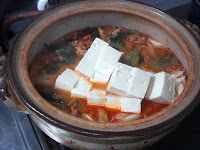Nabe literally translates as "pot" (not the smokeable kind) and almost anything turns into "nabe" if you throw it into a pot. Oh and the number of shapes and sizes of pots in Japan! How I would love to send one of my kids a Japanese ceramic pot but they are heavy and big. I have a feeling my kids were trying to make their nabe dinner in a pan. I don't know if that worked or not.
Takumi: "We are trying to make "dashi" (broth) for our "nabe". How do you make "dashi"?"
Me: "That depends on what kind of dashi you want. If you have a few dried sardines you could throw them in a pot and simmer them for a few minutes."
Takumi: "No dried sardines."
Me: "Okay. How about konbu (seaweed). You could cut a stalk up and simmer that for a few minutes too."
Takumi: "No seaweed."
Me: "Katsuobushi? (dried bonito fish flakes) Do you have any of that? Just simmer that up awhile but remember to strain the broth afterwards."
Takumi: "No fish flakes."
Me: "For heaven's sake! What DO you have?"
Takumi: "Soy sauce, sugar, mirin (sweet rice wine), tsuyu (noodle soup stock)."
Me: "Forget the sugar and mirin. Your best bet is the noodle soup stock."
I don't know how their dinner turned out.
My family's favorite nabe is Kimchi Nabe. 20 or more years ago I clipped a recipe out of a newspaper and it has become yellowed and frayed with age and use. (I once read you could read a family's dinner history by looking at the stained cards in a recipe box. Those are the recipes that were used the most.)
 Ingredients:
Ingredients:Kimchi (Korean pickled vegetables)
thinly sliced pork ...200gms.
green onion
shiitake mushrooms 3-4
miso 1 Tbs
sake 3 Tbs
soy sauce 1 Tbs
tofu 1 block
shishitou or green peppers
natto (fermented beans) 1 pack
garlic 1 clove chopped
sesame seed oil 1 Tbs
 Fry pork and chopped garlic in sesame seed oil.
Fry pork and chopped garlic in sesame seed oil.Add 3 cups water and simmer 2 or 3 minutes.
 Add kimchi. If you don't want it too spicy wash the kimchi first.
Add kimchi. If you don't want it too spicy wash the kimchi first.Add sake and mushrooms, cover and simmer 15 minutes.
 Add miso, natto, and soy sauce and simmer another 10 minutes. Our family really likes the natto so I always add another pack or two.
Add miso, natto, and soy sauce and simmer another 10 minutes. Our family really likes the natto so I always add another pack or two. Add green peppers, green onions, and tofu and heat completely through.
Add green peppers, green onions, and tofu and heat completely through.
Kimchi Nabe is a little spicy but it warms you up nicely on a cold winter day. I'm afraid I don't decorate my nabe up with star cut carrots like in the newspaper picture.
 Takumi and Leiya! Now if you could only find a real "nabe" you could make Kimchi Nabe in your own kitchens... (Assuming you have an oriental market where you can buy miso, kimchi, tofu and natto... At least you don't have to make "dashi".)
Takumi and Leiya! Now if you could only find a real "nabe" you could make Kimchi Nabe in your own kitchens... (Assuming you have an oriental market where you can buy miso, kimchi, tofu and natto... At least you don't have to make "dashi".)







No comments:
Post a Comment